Oh what a summer this has been: I call this my “Fediverse summer” as I went all in on the Fediverse, started a blog about it, signed up and used several projects, carried out interoperability tests between them, federated my Wordpress sites and tried a myriad of apps on both iOS and Android. I feel like I went on an accelerated learning journey, like going from kindergarten to high school in the span of 3 months.
There are some crucial discoveries I made that I would love to share with you today – hoping that they will inform and improve your experience on the Fediverse. But first! It’s important to rewind to a few months ago to see how I got here.
From 1 to 9 Fediverse Accounts
In early June I had ONE Fediverse account: @_elena@mastodon.social. I had signed up for it following Twitter’s sale to that chaotic, malevolent billionaire.
I had been enjoying Mastodon so much, I was peeved by the fact it wasn’t very popular amongst my friends and professional contacts. As that frustration grew, I decided to channel it into a new creative project: a blog/newsletter titled “The Future is Federated”, aiming to introduce the Fediverse to people not familiar with it.
And so it began: my first post was published on my Ghost blog on June 11, 2024 titled “Introducing: The Future is Federated”. In its closing paragraphs I explained my goals: “In the coming days/weeks, I plan on sharing hands-on guides about Mastodon and the Fediverse... and to suggest interesting and diverse accounts across various fields, so that if you are a newbie on here, you can quickly populate your feed.”

I’m smiling reading back those lines because if I had told June 2024 Elena that in 3 months’ time she’d have 9 Fediverse accounts across various projects, she would not have believed it.
Yes, I’m now the proud owner of NINE Fediverse accounts, including:
- Mastodon: @_elena@mastodon.social
- Pixelfed: @elenarossini@pixelfed.social (@ele@photos.elenarossini.com since Jan 2025)
- Friendica: @elena@poliverso.org (@ele@elenarossini.fr since Jan 2025)
- Lemmy: @elena@lemmy.world
- Mbin: @elena@fedia.io
- PieFed: @elena@piefed.social
- my federated Wordpress blog: @ele@elenarossini.com
- the federated Wordpress blog of my project The Realists: @elena@therealists.org
- the federated Wordpress blog of my documentary THE ILLUSIONISTS: @ele@theillusionists.org
I wrote extensive blog posts about interoperability tests between these projects. In case you missed them, you may want to catch up here.

The 3 biggest discoveries I made during my “Fediverse Summer”
I could sum up the biggest discoveries I made over the summer this way:
Lesson 1: It’s all about the instances
Lesson 2: It’s crucial not to take things at face value, but experiment
Lesson 3: It’s important to be strategic about long-term viability
Points number 1 and 2 may be interesting for advanced Fediverse users, while number 3 is for everyone, even newbies.
Lesson no.1: It’s all about the instance(s)
You sign up for a new Fediverse software you are not familiar with - say, Friendica for example. As you play around with it day in and day out, you incur into problems: notifications from other instances don’t show up; you can’t find accounts you know while searching for them in the directory; the most mundane actions result in a spinning wheel as the server response time can be painfully slow. Doubts set in – “Uh oh, maybe Friendica is not so good after all” you may start thinking.
I am speaking from personal experience: this is exactly for happened to me in July as I began using Friendica. I loved all its advanced functionalities but I experienced frustrating bugs on a daily basis.
To be honest, I was beginning to feel nervous about the server I was on: I didn’t know the admin and the original information about the instance was all in German. As I will discuss in point no. 3, the long-term viability of the server I was on was a big question mark for me. And as I published more and more posts about the Fediverse on Mastodon and on my blog, I started exchanging frequently with the admin of the Friendica instance poliverso.org, as well as with Italian users of it, who reported good user experiences and none of the bugs I was encountering.
I had a eureka moment: what if the problems I am experiencing on Friendica are related to the server I am on? And not Friendica itself?
On August 24th I decided to move to a new server: @poliverso.org. Downloading my user data (follow lists) took a couple of clicks. Sign-up for a new account was as easy as could be. I posted this message on Mastodon:
🌞 Notes from my first day on a new #Friendica instance ✨
This morning I switched Friendica instances and WOW what a difference I am already noticing!
I'm not going to badmouth my old instance but I had found it to be slow and not federating correctly with other projects.
For example, I could not find my #Lemmy or #Mbin accounts while searching in its directory... it seemed that communication with Fediverse content aggregators was broken.
My new instance poliverso.org simply ROCKS! 🇮🇹 🚀
Big lesson learned: if you are experiencing problems in a Fediverse project, try switching to a new server. It worked for me, vis-à-vis Friendica*.
Editor's note: as of January 2025 I have moved to my own self-hosted Friendica instance: @ele@elenarossini.fr
Lesson no.2: It’s crucial not to take things at face value, but experiment
Phanpy.social is billed as a “minimalistic opinionated Mastodon web client.”
The iOS apps Mona and Ivory are described by their developers as Mastodon apps; Mona shows up on the Apple iOS store as “Mona for Mastodon,” whereas the website for Ivory says “Ivory is a brand new app that brings 10 years of experience building the award-winning Twitter app, Tweetbot, over to Mastodon.”
I can’t remember why I had this idea but in July I thought to myself: what happens if I try to log onto Ivory with my Pixelfed credentials?
And so I did.
And things worked beautifully: I was able to scroll through my Pixelfed feed using an app originally intended for Mastodon.
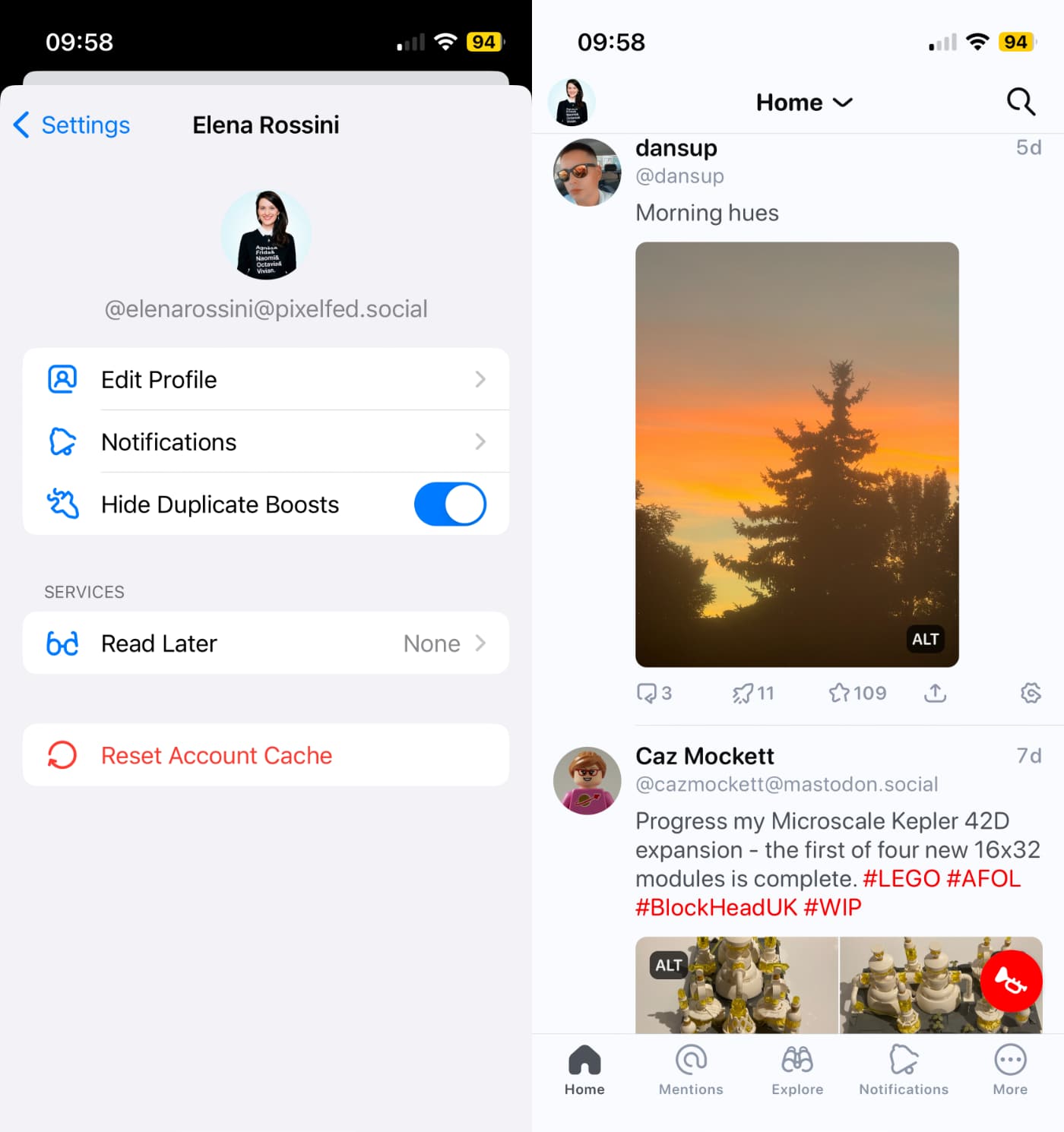
This is the beauty and the magic of ActivityPub: interoperability between Fediverse software seamlessly works.
I was able to add multiple Fediverse accounts to Ivory: logging in with my Mastodon, Friendica and Pixelfed credentials.
Switching between these accounts in Ivory was - is - quick and easy.
For the sake of convenience, I decided to use the app Ivory for Mastodon and Mona Pro for Friendica. The experience is, once again, beautiful and just seamless:
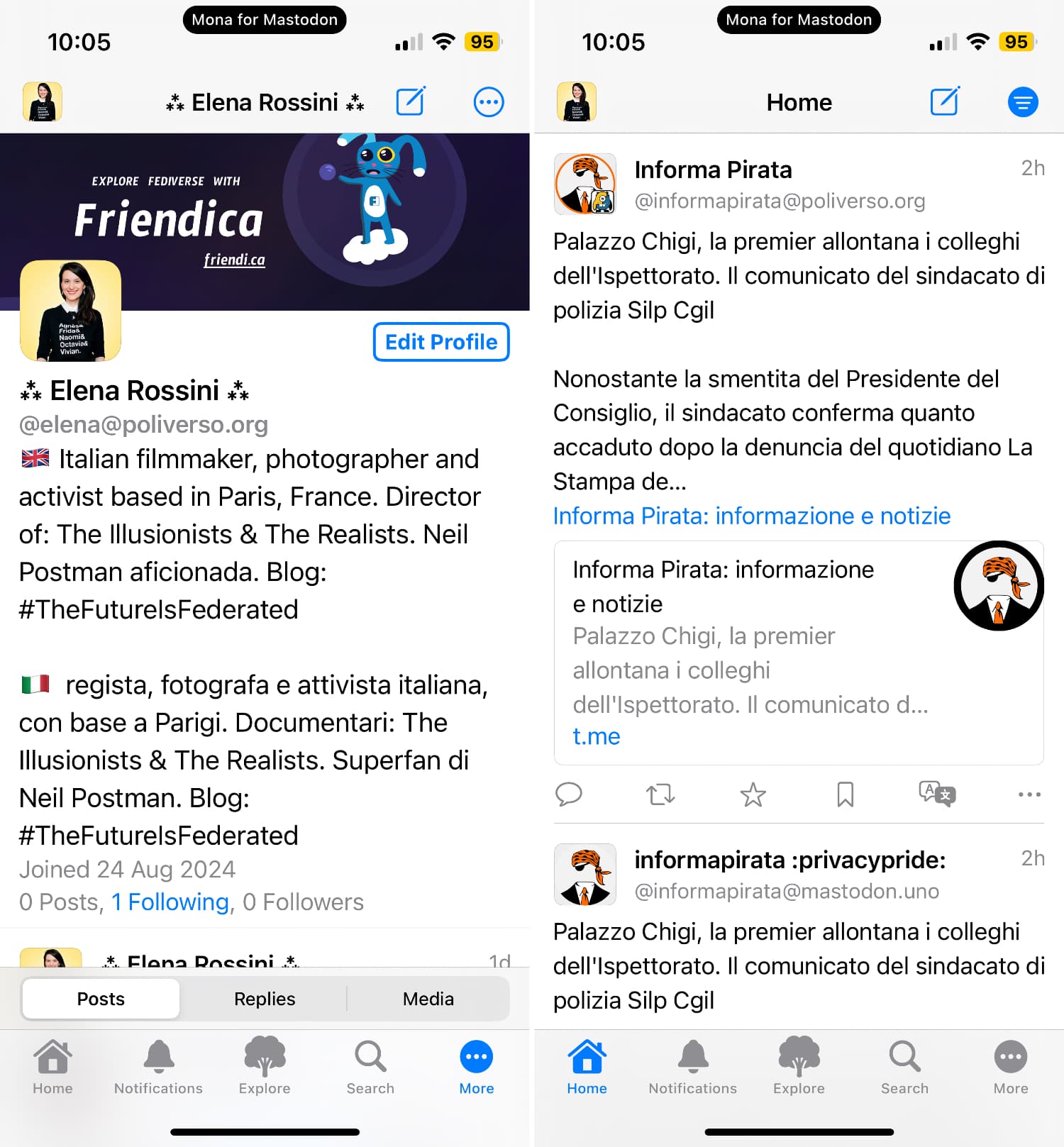
This works not only on iOS but also for Android phones: I use the official Mastodon app for my Mastodon account and Tusky for my Friendica account:
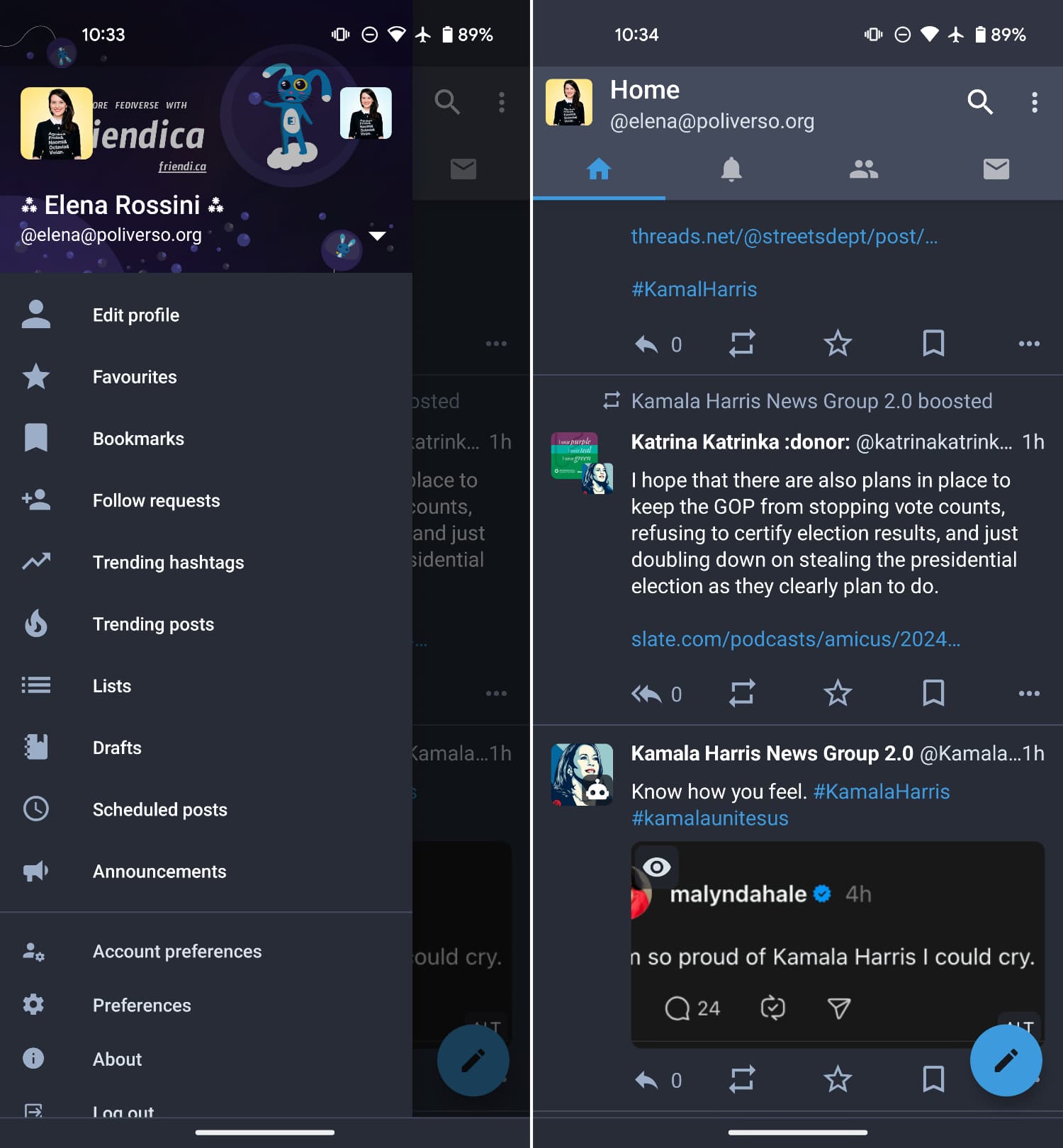
Isn't this wonderful? But it doesn't stop here.
I often sing the praises of the web client Phanpy.social – in my opinion, it’s the best social media desktop client ever made. Its catch-up feature is pure genius and allows users to smartly read messages one may have missed since the last time they were online.
Phanpy.social already earns 5 stars in my book. Things is, there are two additional facts that truly make Phanpy shine: interoperability and mobile responsiveness.
You can sign in Phanpy with your Pixelfed and Friendica credentials and thus use Phanpy’s phenomenal catch up feature with these projects.
Here is what my Pixelfed "catch-up" feed looks like in Phanpy:
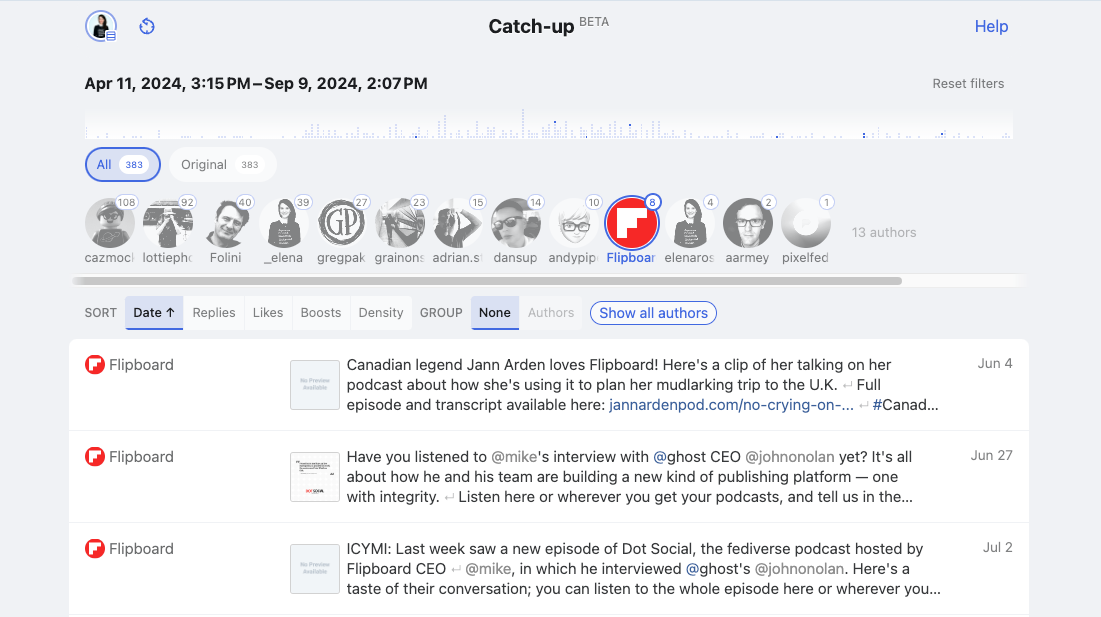
I made another discovery accidentally: I was out of the house, away from my computer, and curious to see which posts I had been missing on Mastodon since I had not logged on in a few days. I opened Safari on my iPhone 13 Mini, went to the https://phanpy.social website and logged in with my Mastodon credentials. I was astonished - and delighted - to see that Phanpy has a beautiful and super responsive mobile site:
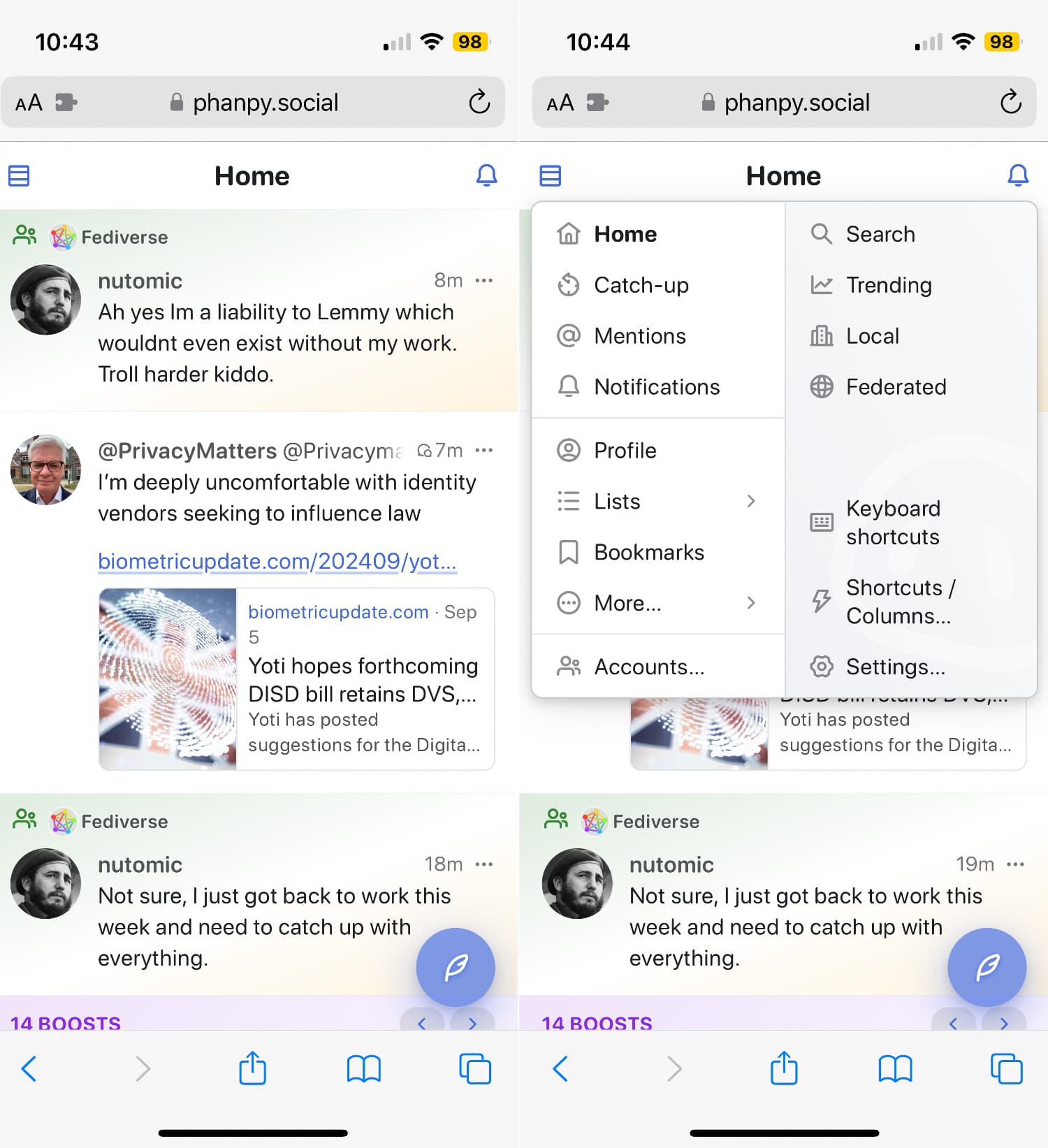
I accidentally stumbled onto these things: the fact that made-for-Mastodon apps and web clients also work really well with other projects, thanks to the magic of ActivityPub.
So my second lesson is: don’t take things at face value on the Fediverse - experiment… you may be positively surprised by what you find.
Lesson no.3: Take into account the long-term viability of Fediverse projects
The longevity - or long-term viability - of social platforms is always on my mind. That has been the case since the sale of Twitter and the folding of the social network Telepath, which occurred in the span of two months, from mid-September to late October 2022. I had been using both on a daily basis, with communities and friends I was fond of. Their collapse had a profound impact on me: I am still feeling a sense of loss two years later. I vowed to “never again” invest my time, mind and heart in online places that could be destroyed (as with Twitter) or fold with a short notice (Telepath).
This is what brought me to the Fediverse: the promise of independent, federated networks that give power back to users, with full ownership of one’s data and followers.
That said, the Fediverse is not immune from loss of communities - far from it. This summer, two popular Fediverse projects were abruptly discontinued: I’m thinking of the popular content aggregator Kbin and the MissKey fork Firefish.
If you are a Fediverse newbie and what I just typed sounds like a foreign language, let me explain: Kbin was a content aggregator, similar to Lemmy (think Reddit, but on the Fediverse), which had amassed a loyal following. Interoperability on Kbin worked splendidly… it was seen as an enhancement of Lemmy. Until… it wasn’t.
From what I have read online, Kbin was maintained by only one developer and because of health and/or personal reasons, the work on it became too overwhelming. So the project simply went offline. Lemmy user @MoogleMaestro@lemmy.zip discussed this in a Lemmy post, giving insights into what happened and arguing for the importance of account and community portability. Read it here: https://lemmy.world/post/18432763
Firefish - a fork of MissKey – had a similar fate. A critical update from developer naskya was shared on Lemmy: https://lemmy.world/post/19440796
As of today’s release, Firefish will enter maintenance mode and reach end-of-support at the end of the year. The main reasons for this are as follows.
In February, Kainoa suddenly transferred the ownership of Firefish to me. This transition came without prior notice, which took me aback. I still wish Kainoa had consulted with me in advance. At that time, some people were already saying that “Firefish is coming back”, making it challenging to address the situation. Also, since there were several hundred active Firefish servers at that point, I could not suddenly discontinue the project, so I took over the project unwillingly.
Over the past seven months, I have been maintaining Firefish alone. All other former maintainers have left, leaving me solely responsible for managing issues, reviewing merge requests, testing, and releasing new versions. This situation has had a significant impact on my personal life.
My Mastodon account will continue to be my main home on the Fediverse. I have trust in its long term plans and longevity, especially after witnessing what happened recently with Kbin and Firefish. There is strength in numbers: the Mastodon server I am on (mastodon.social) has 2 million users. Mastodon earns over 19,000 Euros a month via Patreon donations. This gives me peace of mind: it is unlikely it will easily disappear - there are so many people invested in its success. But still, I plan on downloading my user data periodically, so that I will feel more in control, should things go south.
Lesson no.3: before investing a lot of time in a Fediverse software/instance, do your research and be strategic about its long term viability.
Wrapping Up
My explorations of the Fediverse have just started and I’m excited about the future and trying out other projects: Matrix and Sharkey will be next.
If you want to catch up on previous issues of The Future is Federated, you will find them on this page:

As always, thanks for being here.
Elena
💓 Did you enjoy this post? Share it with a friend!
👫 Follow me on Mastodon (my favorite network!) or Pixelfed. All my other links are available here: elena.social
📽️ If you'd like to support my work, you could buy or rent my documentary The Illusionists on the globalization of beauty. Watch the teaser:

💌 If you'd like to say hi, my contact information is here
✏️ If this post resonated with you, leave a comment!




